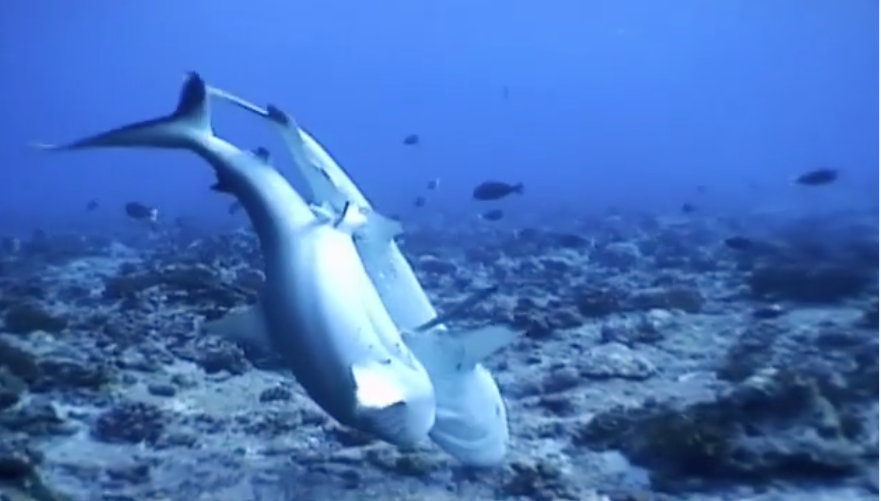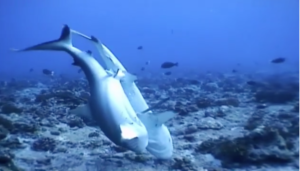Sharks…. What do you think when you hear that word? Fear? Excitement? If you are a diver, probably excitement. For most people, it is an unfounded fear, thanks primarily to movie and tv shows that portray sharks as “man eating” monsters that just attack humans at random. I find it interesting that we can be excited and probably a bit apprehensive when we talk about seeing a shark, but when we do finally see one on a dive, every single diver swims TOWARDS the animal to get a better view…. Very interesting… and intriguing!
One of the most fascinating aspects of the shark is the reproduction system. It is believed that most sharks go to the open ocean to mate, although that is not the case in the below video. Male sharks (and rays) are equipped with claspers, which are a pair of organs located very close to the pelvic fin. Females have oviducts, which are essentially like a fallopian tube that leads straight to the womb.
The male will insert the claspers into the oviduct and release semen fertilizing the female’s eggs. Sounds easy right? Wrong! This is no easy feat, especially since most sharks can’t mount each other. They have to keep swimming, or so we think. Sharks have very rarely been seen mating, although I did find 1 video. Talk about rough! Click on this picture to watch the video.
I can honestly say I am glad that I am not a female grey reef shark !
So, once the eggs are fertilized, reproduction can begin and the new baby sharks can grow. Depending on the species of shark, this process can be totally different. Why? It can depend on the species itself and its size, along with the environment.
There are four different ways that sharks reproduce: Viviparous, oviparous, ovoviviparous, and asexually. Can you even pronounce all of those? Wow… so similar, yet different.
Viviparity
This is very similar to how humans are born – the egg develops inside of the womb, and will have a live birth, placenta and all. What is different is that the shark pups will hatch inside of the womb and live off the placenta until they are ready to birth. Each shark has an umbilical cord that is located between the pectoral fins. This cord, just like in humans, delivers to them nutrients and oxygen from the mother’s bloodstream. Typically, sharks that have viviparous births tend to have small litters, like 2-20 depending on species. The gestation period varies according to the species and can be anywhere from 7 months to three years. 3 YEARS !!! Can you believe that? Some species of sharks that birth this way are Bull Sharks, Hammerheads, Lemon, Mako and White tip sharks… just to name the most commonly known ones. There are many more.
Oviparity
This is when a shark lays eggs in a deposit in the water. Sharks are “true oviparous” animals meaning the egg is fertilized in the womb then an egg sac is laid. About 40% of all sharks are oviparous. The egg sack is kind of like a leathery pouch, commonly referred to as a “mermaid’s purse.” And that is it, Mom is free to go…… Unfortunately, since the eggs are left unprotected, they are often eaten by predators before they can hatch. The eggs spend weeks in the womb before being laid, and may take months to hatch. Depending on the species, the female will lay anywhere from 10 to 200 eggs. Some of the sharks that reproduce like this are Bamboo Sharks, Epaulette Sharks of Indonesia, and others that I have never heard of. Maybe I should make a bucket list to see them….. catsharks, horn sharks, necklace carpet sharks, Port Jackson sharks, swell sharks and zebra sharks – have you heard of them ???
Ovoviviparity
This is when the egg hatches inside of the womb and the shark has a live birth. Sound a lot like Viviparity?? I thought so too. The difference is that there is no placenta. The fertilized eggs are in an egg sac that only provides them oxygen. The pups living inside the womb will live off a yolk sac from the egg until they are ready to hatch. And they hatch but remain inside the female until they are fully grown. Sometimes, there is fetal cannibalism, meaning that the first shark to hatch from their egg will consume unfertalized eggs, or the other shark fetuses and their yolk sacs – in order to survive. This actually helps insure the survival of the fittest. Ovoviviparous sharks usually give birth to VERY small litters – 1-8 pups. Except in the case of Whale sharks. One specimen was found with over 300 pups in her belly. Sharks species that reproduce like this are Great White Sharks, Nurse Sharks, Thresher Sharks, Sand Tiger or Ragged Tooth Sharks (we saw them in South Africa), Sawsharks, Tiger Sharks… just to name a few……
Asexual Reproduction
Rarely, VERY rarely, asexual reproduction can occur. I don’t mean to state the obvious, but this is when a female shark gives birth without any contact with a male. After seeing that video of the sharks mating, this might be the optimal way. Does this sound a bit unbelievable? What is actually happening is the egg is being cfertilized by an adjacent cell. There are 2 very well-documented cases. One very famous was a Zebra shark in an Australian aquarium in 2017. The female had not had a male shark in the same tank for over 3 years. When the pups DNA was tested, there were only genes from the female, thus eliminating the possibility that she had stored sperm for over 3 years. This has only been documented when sharks are in captivity, or there are no available males. It’s not exactly the most ideal way to reproduce because it is severely limiting the genetic diversity, but it is useful when the sharks are under environmental distress. Sharks are not the only species that can aexually reproduce. Snakes, birds and Komodo dragons have also been known to reproduce this way.
So there you have it – 4 ways for sharks to reproduce. As you can see, it sometimes takes years for sharks to breed. And with 100 million sharks being killed every year, you can see why sharks are considered endangered. In addition, it takes years for sharks to become sexually mature. So, the best way to preserve the species is to reduce the number of sharks that are killed every year.


